- IN ABEYANCE
- The term used when a flag or office is no longer in current use, but which may be re-introduced at some
future date – with examples being the rank flag of Marshal of France (which office has no extant holder) and
the broad pennant of a commodore first class (a rank in abeyance since 1958 –
see the second note following ‘flag captain’; also
‘broad command pennant 2)’ and
‘rank flag 1)’).
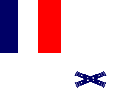
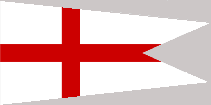
Rank Flag of a Marshal of France (fotw); Former First Class Commodore’s Broad Pennant, UK
- IN ANNULO
- The heraldic term used when a series of objects are set equidistant around a central point –
see ‘annulet’.
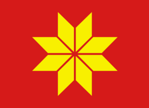

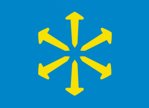

Flag and Arms of Ulvik, Norway (fotw & Tomislav Šipek); Flag and Arms of
Bindal, Norway (fotw)
- IN BASE
- The heraldic term used when a charge or charges appear in the lower part of a shield, banner
of arms or flag – see
‘base 1)’ (also
‘abased’, ‘banner of arms’, and
‘shield’).

- IN BEND
- The heraldic term used when an object, charge or charges on a shield, a banner of
arms or any quartering thereof are placed diagonally from top left to bottom right
across the field – but see ‘bendwise 2) (also ‘banner of arms’, ‘bend’,
and ‘per bend’ and
‘quartering 1)’).

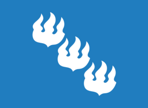

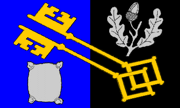
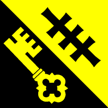
Arms and Flag of Hřyanger, Norway (Tomislav Šipek); Chief of Naval Staff, Italy (fotw); Arms and Flag of
Surrey, UK (fotw); Flag of Vals, Switzerland (fotw)
- IN BEND SINISTER
- The heraldic term used when an object, charge or charges on a shield, a
banner of arms or any quartering thereof are placed diagonally from bottom
left to top left right across the field – but see ‘bendwise 2)
(also ‘banner of arms’, ‘bend sinister’,
‘per bend sinister’
and ‘quartering 1)’).
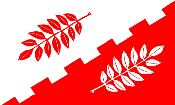

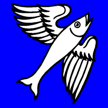
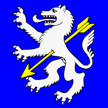
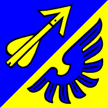
Flag and Arms of Altenhof, Germany (fotw); Flag of Frasco, Switzerland (fotw); Flag of Wolfenchiessen, Switzerland (fotw); Flag of
Luzein, Switzerland (fotw)
- IN CHIEF
- 1) The heraldic term used when a charge or charges appear in the upper part of a shield, banner of arms or flag – see ‘chief’
(also ‘banner of arms’, ‘enhanced’ and
‘shield’).
2) In English naval usage now obsolete, a term officially employed to describe a charge placed in the upper hoist canton
– see ‘canton 2)’.

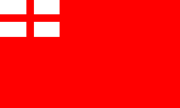
Example; English Red Ensign c1625 – 1707 (fotw)
- IN COMMISSION
- In British RN, USN and some other usage, the phrase used to describe a warship that is active, manned and ready for combat – see ‘masthead pennant 1)’.

Commissioning Pennant of South Africa (fotw)
- IN FESS
- The heraldic term used when an object, charge or charges on a shield, a banner of
arms or any quartering thereof appear in a horizontal
position – but see ‘fesswise 2)’ and the note below (also ‘banner of arms’, ‘fess’,
‘per fess’ and
‘quartering 1)’).
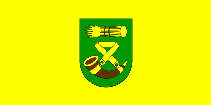

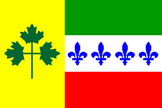
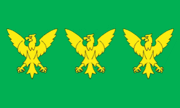
Flag and Arms of Bilje, Croatia (fotw); Flag of the
Comité d'action francophone Pontiac, Canada (fotw); Flag of
Caernarfonshire, UK (fotw)
Please note charges can be arranged in fess but orientated palewise as per the examples below, with would be blazoned as “…three shovels palewise in fess”’
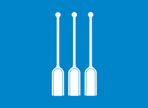

Flag and Arms of Lom, Norway (Tomislav Šipek)
- IN PALE
- The heraldic term used when an object, charge or charges on a shield, a
banner of arms or any quartering thereof appear in a vertical position – but see ‘palewise 2)’ (also
‘banner of arms’, ‘pale’, and ‘per pale’
and ‘quartering 1)’).
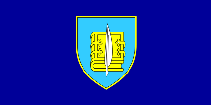

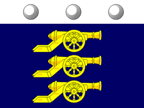
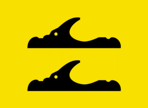

Flag and Arms of Stankovci, Croatia (fotw);
Banner of Arms of the Ordnance Board 1804 – c1960, UK (fotw);
Flag and Arms of Radřy, Norway (fotw)
- IN PALL
- The heraldic term used when the charges on a shield, a banner of arms or a flag are arranged in the form of a pall – see
‘pall 2)’ and ‘per pall’.
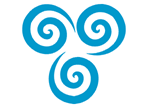

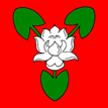

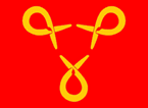
Flag and Arms of Fusa, Norway (fotw); Flag of
Ebikon, Switzerland (fotw); Arms and Flag of
Masfjorden, Norway (fotw)
- IN SALTIRE
- The heraldic term used when two separate objects or charges are placed
across each other diagonally on a flag, shield or banner of arms - saltirewise
(see also ‘banner of arms’, ‘saltire’ and
‘per saltire’.
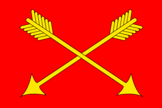

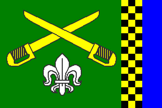
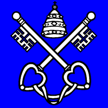
Proposed Flag of Virton, Belgium (fotw); Arms and Flag of
Vojkovice, Czech Republic (fotw); Flag of
Ascona, Switzerland (fotw)
- INACTIVE
- In vexillology a term that may be used to describe when the rays of a star or sun emblem, or a radiating
stripe, are straight-edged – see ‘active’ (also
‘active and inactive’,
‘radiating’,
‘rays 1)’ and
‘star’ and its following note,
‘sun emblem’ and
‘sunburst’).
![[inactive example]](../images/v/vxt-d623.gif)
![[inactive example]](../images/v/vxt-d1741.gif)
![[inactive example]](../images/v/vxt-d2825.gif)
Flag of Groot-Ammers, Netherlands (fotw); Flag of
Sarawak, Malaysia (fotw); Flag of
Bodř, Norway (fotw)
- INCENSED
- 1) The heraldic term for when a wild beast has fire issuing from its mouth or eyes.
- 2) A term sometimes incorrectly used in place of ‘inflamed’ – see ‘inflamed’.

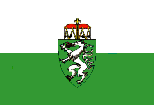

Arms of Maria Alm am Steinernen Meer, Austria (ICH); Flag and Arms of
Styria, Austria (fotw)
Please note with regard to 1) that only a wild beast should be described as “incensed”, and that other charges are “inflamed”.
- INCLINED FLY
- A term used when the fly of a flag is cut diagonally so that the upper length
of the flag is greater than its lower length – a type largely limited to Central
Europe (see also ‘length 1)’,
‘schwenkel’ and
‘swallow-tail(ed)’).
![[inclined fly flag]](../images/v/vxt-d175.gif)
![[inclined fly flag]](../images/v/vxt-d175a.gif)
![[inclined fly flag]](../images/v/vxt-d175b.gif)
From left: Flag of Jarocin County, Poland (fotw); Flag of
Pleszew County,
Poland (fotw); Flag of Janów Lubelski County, Poland (fotw)
Please note that this is not an established term, but has been introduced by the Editors since no suitable
(or suitably descriptive) alternative could be found.
- INCRESCENT (or INCREMENT)
- See ‘moon 2)’ with following note.

Flag of Oron-la-ville, Switzerland (fotw)
- INDENTED
- 1) The heraldic term used when the edge of an ordinary or the partition
line on a shield, banner of arms or flag is notched as in ‘dancetty’ but with smaller/narrower teeth - endented.
2) See ‘embattled’).

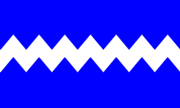
Example (Parker); Flag of Munxar, Malta (fotw)
- INDENTED EDGE
- See ‘scalloped 1)’.
![[indented edge example]](../images/v/vxt-d2747.gif)
![[indented edge example]](../images/v/vxt-d1529.gif)
Two Merchant Flags, Portugal 16th/17th Century (fotw)
- INDENTATION(S)
- A term that may be used to describe the shape remaining at the fly of a flag or pennant where that
fly has been cut into two or more tails - see ‘swallow-tail(ed)’ (also
‘hussar cut’,
‘palm’, ‘pennant 2)’,
‘swallow-tail and tongue’ and
‘tongues’).
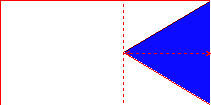
- INDIVIDUAL FLAG.
- In U.S. army usage, the flag denoting an officer's rank – see
‘rank flag 1)’
(also ‘distinguishing flag 3)’,
‘flag of command’ and
‘personal flag 4)’).
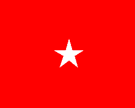
Individual/Rank Flag of a Brigadier General, US Army (fotw)
- INDOOR FLAG
- A flag made expressly for display inside a building and sometimes fringed.
It is often made from more costly materials, is enhanced by embroidered detail, and is fitted
with a sleeve for attachment to a staff – a dress flag or flag of ceremony (see
also ’ceremonial flag 1)’,
‘cord’,
‘embroider’,
‘flag spreader’,
‘fringe’, ‘sleeve 2)’,
‘staff 2)’ and
‘tassels’).
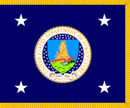
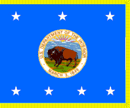
Indoor Flag of The Secretary of Agriculture, US (fotw); Indoor Flag of The
Secretary of The Interior, US (fotw)
- INESCUTCHEON
- The heraldic term for one shield appearing within another (usually – but
not invariably - at its centre point) or on a banner of arms – but see notes below (also ‘banner of arms’,
‘coat of arms’
‘escutcheon’,
‘escutcheon of pretence 1)’,
‘escutcheon of pretence 2)’,
‘overall’
and ‘quartering 1)’).

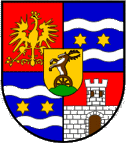
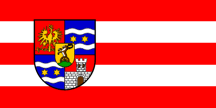

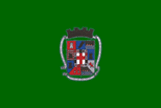
Royal Standard 1700 – 1759, Spain (fotw); Arms and Flag of
Varaždin County, Croatia (fotw); Arms and Flag of
Almeria
Province, Spain (Klaus-Michael Schneider and fotw)
Notes
a) Please note Some heraldic sources propose that this term should also be used when more than one shield appears within another, but it is suggested that a suitable glossary or heraldic dictionary should be consulted for further information.
b) However, one further (authoritative) source states that an inescutcheon should be placed on or near the fess-point, and that the term “escutcheon” be used for any that are seen in another position – see ‘honour-point 2)’.
- INFLAMED
- The heraldic term used when a charge is shown with flames coming from it –
ardent, enflamed or flamed – but see ‘incensed 1)’
(also ‘flamant’).
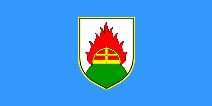

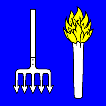

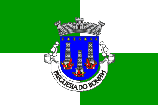
Flag and Arms of Gornja Stubica, Croatia (fotw); Flag of Geroldswil, Switzerland (fotw);
Arms and Flag of Bonfim, Portugal (Sergio Horta)







































![[inactive example]](../images/v/vxt-d623.gif)
![[inactive example]](../images/v/vxt-d1741.gif)
![[inactive example]](../images/v/vxt-d2825.gif)



![[inclined fly flag]](../images/v/vxt-d175.gif)
![[inclined fly flag]](../images/v/vxt-d175a.gif)
![[inclined fly flag]](../images/v/vxt-d175b.gif)



![[indented edge example]](../images/v/vxt-d2747.gif)
![[indented edge example]](../images/v/vxt-d1529.gif)















